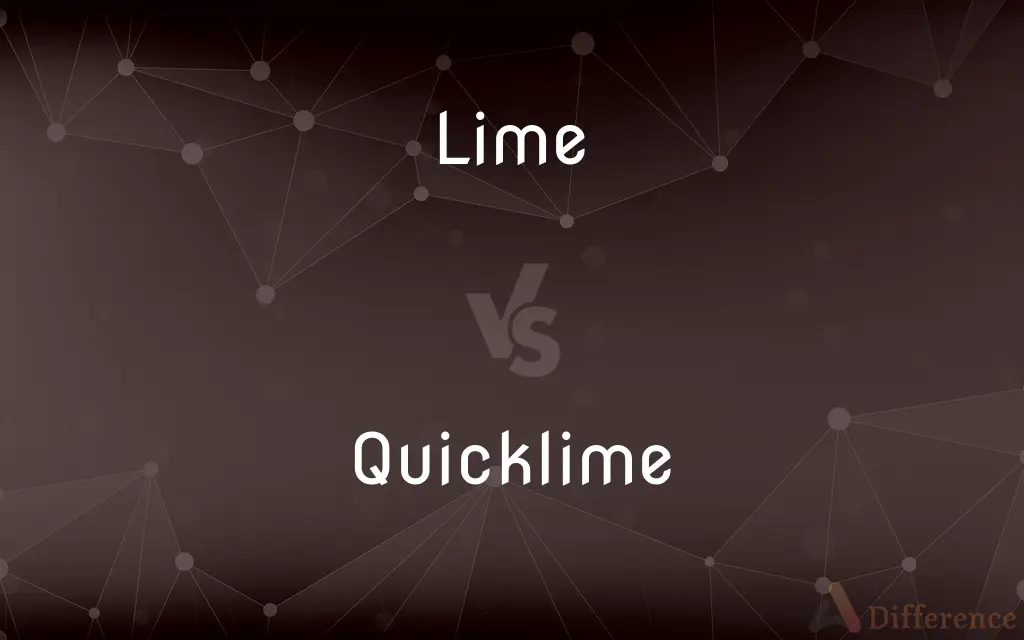Lime vs. Quicklime — What's the Difference?
Edited by Tayyaba Rehman — By Fiza Rafique — Updated on April 15, 2024
Lime, primarily composed of calcium carbonate (CaCO3), is used in cooking and agriculture, while quicklime, or calcium oxide (CaO), is a caustic alkaline substance used in cement and environmental applications.

Difference Between Lime and Quicklime
Table of Contents
ADVERTISEMENT
Key Differences
Lime, often referred to as limestone or agricultural lime, is naturally occurring and is mainly used to adjust soil pH to promote plant health. In contrast, quicklime is produced by heating limestone to a high temperature, which drives off carbon dioxide, resulting in a highly reactive form of calcium oxide.
In culinary contexts, lime typically refers to the green citrus fruit, adding flavor and acidity to dishes, whereas quicklime is inedible and highly caustic, making it suitable for industrial, not culinary, applications.
Lime is commonly used in its natural form in landscaping and as a component of mortar in building materials. On the other hand, quicklime reacts with water in a process called slaking, forming slaked lime (calcium hydroxide), which is used to make plaster and cement.
Lime is spread on fields to neutralize acidic soils, thereby improving nutrient availability and crop yields. Quicklime, however, is used for more intensive chemical processes, such as treating wastewater, flue gas, and hazardous waste due to its strong alkalinity.
In terms of handling, lime is relatively safe to handle, posing minimal health risks. Quicklime is much more hazardous; it can cause severe burns upon contact with moisture, requiring careful handling and proper safety equipment.
ADVERTISEMENT
Comparison Chart
Composition
Mostly calcium carbonate (CaCO3)
Mostly calcium oxide (CaO)
Uses
Soil pH adjustment, building material
Cement making, chemical processing
Production Method
Mined as limestone
Produced by heating limestone
Safety
Generally safe to handle
Caustic, can cause severe burns
Environmental Role
Neutralizes soil acidity
Treats wastewater and hazardous waste
Compare with Definitions
Lime
Soil amendment.
Lime is added to acidic soils to raise the pH and improve plant health.
Quicklime
Chemical production.
Quicklime reacts with water to produce slaked lime, used in cement and plaster.
Lime
Building material.
Lime is used in the mixture for mortar and plaster in traditional construction.
Quicklime
High reactivity.
Quicklime reacts vigorously with water, releasing heat in an exothermic reaction.
Lime
Gentle on ecosystems.
Lime is used in lakes to neutralize acid rain effects without harming aquatic life.
Quicklime
Industrial use.
Quicklime is essential in the manufacture of steel and glass.
Lime
Natural occurrence.
Lime, in the form of limestone, forms significant parts of the Earth's crust.
Quicklime
Environmental treatment.
Quicklime is used to treat wastewater by adjusting pH and precipitating pollutants.
Lime
Culinary use (Citrus).
Lime juice is popular in culinary dishes for its tart, refreshing flavor.
Quicklime
Hazardous handling.
Quicklime must be handled with protective gear due to its caustic nature.
Lime
A white caustic alkaline substance consisting of calcium oxide, which is obtained by heating limestone and which combines with water with the production of much heat; quicklime.
Quicklime
A white caustic alkaline substance consisting of calcium oxide, which is obtained by heating limestone and which combines with water with the production of much heat; lime.
Lime
Birdlime.
Quicklime
See calcium oxide.
Lime
A rounded citrus fruit similar to a lemon but greener, smaller, and with a distinctive acid flavour
Wedges of lime
Lime juice
Roughly chop two limes
Quicklime
Calcium oxide, which is produced by heating (calcining) limestone and gives slaked lime on treatment with water.
Lime
The evergreen citrus tree which produces limes, widely cultivated in warm climates.
Quicklime
(transitive) To treat with quicklime.
Lime
A bright light green colour like that of a lime
A lime-green bikini
Quicklime
Calcium oxide; unslacked lime; - so called because when wet it develops great heat. See 4th Lime, 2.
Lime
A deciduous tree with heart-shaped leaves and fragrant yellowish blossom, native to north temperate regions. The pale timber is used for carving and inexpensive furniture.
Quicklime
A white crystalline oxide used in the production of calcium hydroxide
Lime
An informal social gathering characterized by semi-ritualized talking.
Lime
Treat (soil or water) with lime to reduce acidity and improve fertility or oxygen levels
They were liming acidified lakes
Lime
Catch (a bird) with birdlime
The bird that hath been limed in a bush
Lime
Sit or stand around talking with others
Boys and girls were liming along the roadside as if they didn't have anything to do
Lime
Any of several evergreen trees or shrubs of the genus Citrus having edible green or greenish-yellow fruit, especially the Mexican lime and the Persian lime.
Lime
The fruit of any of these plants, having a pulpy interior and usually acid juice.
Lime
See linden.
Lime
See calcium oxide.
Lime
Any of various mineral and industrial forms of calcium oxide differing chiefly in water content and percentage of constituents such as magnesia, silica, alumina, and iron.
Lime
Birdlime.
Lime
To treat with lime.
Lime
To smear with birdlime.
Lime
To catch or snare with or as if with birdlime.
Lime
(chemistry) Any inorganic material containing calcium, usually calcium oxide (quicklime) or calcium hydroxide (slaked lime).
Lime
(poetic) Any gluey or adhesive substance; something which traps or captures someone; sometimes a synonym for birdlime.
Lime
(theatre) A spotlight.
Lime
A deciduous tree of the genus Tilia, especially Tilia × europaea; the linden tree.
Lime
The wood of this tree.
Lime
Any of several green citrus fruit, somewhat smaller and sharper-tasting than a lemon.
Lime
Any of the trees that bear limes, especially Key lime, Citrus aurantiifolia.
Lime
(uncountable) A brilliant, sometimes yellowish, green colour associated with the fruits of a lime tree.
Lime
A casual gathering to socialize.
Lime
(transitive) To treat with calcium hydroxide or calcium oxide (lime).
Lime
(transitive) To smear with birdlime.
Lime
(rare) To ensnare, catch, entrap.
Lime
(transitive) To apply limewash.
Lime
To hang out/socialize in an informal, relaxed environment, especially with friends, for example at a party or on the beach.
Lime
Containing lime or lime juice.
Lime
Having the aroma or flavor of lime.
Lime
Lime-green.
Lime
A thong by which a dog is led; a leash.
Lime
The linden tree. See Linden.
Lime
The fruit of the Citrus aurantifolia, allied to the lemon, but greener in color; also, the tree which bears it.
Lime
The color of the lime{1}, a yellowish-green.
Lime
Birdlime.
Like the limeThat foolish birds are caught with.
Lime
Oxide of calcium, CaO; the white or gray, caustic substance, usually called quicklime, obtained by calcining limestone or shells, the heat driving off carbon dioxide and leaving lime. It develops great heat when treated with water, forming slaked lime, and is an essential ingredient of cement, plastering, mortar, etc.
Lime
To smear with a viscous substance, as birdlime.
These twigs, in time, will come to be limed.
Lime
To entangle; to insnare.
We had limed ourselvesWith open eyes, and we must take the chance.
Lime
To treat with lime, or oxide or hydrate of calcium; to manure with lime; as, to lime hides for removing the hair; to lime sails in order to whiten them; to lime the lawn to decrease acidity of the soil.
Land may be improved by draining, marling, and liming.
Lime
To cement.
Lime
Having a yellowish-green color like that of the lime (the fruit).
Lime
A caustic substance produced by heating limestone
Lime
A white crystalline oxide used in the production of calcium hydroxide
Lime
A sticky adhesive that is smeared on small branches to capture small birds
Lime
Any of various related trees bearing limes
Lime
Any of various deciduous trees of the genus Tilia with heart-shaped leaves and drooping cymose clusters of yellowish often fragrant flowers; several yield valuable timber
Lime
The green acidic fruit of any of various lime trees
Lime
Spread birdlime on branches to catch birds
Lime
Cover with lime so as to induce growth;
Lime the lawn
Common Curiosities
What is the primary use of lime in agriculture?
Lime is used to increase soil pH and improve soil quality for agricultural purposes.
What is quicklime used for in industry?
Quicklime is used in the production of cement, steel, and glass, and for environmental cleanup processes.
What are the safety concerns with quicklime?
Quicklime can cause severe chemical burns upon contact with moisture, including skin moisture.
What are the environmental benefits of using lime?
Lime helps to neutralize acidic soils and lakes, promoting healthier ecosystems.
What happens when quicklime is mixed with water?
Mixing quicklime with water results in a vigorous exothermic reaction, producing slaked lime (calcium hydroxide).
How is quicklime made from lime?
Quicklime is made by heating limestone (lime) to about 900°C, which removes carbon dioxide and leaves calcium oxide.
Can both forms of lime be used in construction?
Yes, both forms are used; natural lime as a traditional building material, and quicklime-derived products in modern construction materials.
What industries rely heavily on quicklime?
The steel, glass, and construction industries use large quantities of quicklime.
How does the handling of lime and quicklime differ?
Lime is relatively safe to handle, while quicklime requires careful handling and protective equipment due to its causticity.
Can lime be used in food?
Yes, the citrus fruit known as lime is extensively used in cooking and beverages for its acidic and flavorful juice.
How do lime and quicklime differ chemically?
Lime is primarily calcium carbonate, while quicklime is calcium oxide, a more reactive compound.
How does lime help in water treatment?
Lime is used in water treatment plants to soften water by removing carbonate hardness.
Is quicklime dangerous to transport?
Yes, quicklime is dangerous to transport because it reacts with moisture, requiring specialized containers.
What are the historical uses of lime?
Historically, lime has been used for centuries in building, farming, and even in burial rites to prevent decay.
How does quicklime help in flue gas treatment?
Quicklime helps remove sulfur dioxide from flue gases in power plants, reducing air pollution.
Share Your Discovery

Previous Comparison
Chatter vs. Gibberish
Next Comparison
Ship vs. SteamerAuthor Spotlight
Written by
Fiza RafiqueFiza Rafique is a skilled content writer at AskDifference.com, where she meticulously refines and enhances written pieces. Drawing from her vast editorial expertise, Fiza ensures clarity, accuracy, and precision in every article. Passionate about language, she continually seeks to elevate the quality of content for readers worldwide.
Edited by
Tayyaba RehmanTayyaba Rehman is a distinguished writer, currently serving as a primary contributor to askdifference.com. As a researcher in semantics and etymology, Tayyaba's passion for the complexity of languages and their distinctions has found a perfect home on the platform. Tayyaba delves into the intricacies of language, distinguishing between commonly confused words and phrases, thereby providing clarity for readers worldwide.














































